Resonance Pathway
An Invitation
Sound is more than what we hear — it is what we are.
Every cell of your body is vibrating, each breath reshaping your inner atmosphere, each thought and feeling resonating through the living field around you.
In this way, sound is not merely an external phenomenon; it is the architecture of life itself.
The ancient mystics knew this. The modern sciences confirm it. And somewhere deep within, your own body remembers it.
Resonance Pathway is not a set of articles to simply read — it is a living passageway.
Each of the ten sections is a chamber within a temple of resonance, guiding you to explore, feel, and integrate the truth that you are an instrument of coherence.
Along this journey, you will:
- Step into The Body as Sound Temple, discovering how flesh, bone, water, and subtle fields receive, translate, and radiate vibration.
- Enter The Language of Harmonics, where pitch, tone, tempo, and volume reveal themselves as living currents shaped by intention.
- Hear The Unheard Orchestra — the silent symphonies of infrasound, ultrasound, planetary hums, and subtle fields that quietly sculpt your inner state.
- Stand before The Sonic Mirror, learning how harmful, healing, and neutral sounds awaken different responses in your nervous system — and how nature’s voice restores balance.
- Remember Music as Memory Key, unlocking emotional landscapes, cultural stories, and soul-level timelines held in melody and rhythm.
- Awaken The Body’s Native Instrument, exploring humming and vocal toning as powerful pathways to self-tuning and deep inner calm.
- Witness Visible Harmonics, where cymatics makes the geometry of sound visible in water, particles, and living cells.
- Clarify The Trinity of Tone — the relationship between sound, frequency, and vibration — and how to sense them distinctly.
- Explore Tuning Keys of the Soul, approaching specific frequencies as living invocations that invite transformation.
- Enter The Embodied Portal, where breath, sound, silence, and nature resonance become your daily gateways to harmonic alignment.
This is a spiral, not a straight road.
You may walk this pathway in order, or step into the chamber that calls to you most deeply. Each one is complete in itself, yet together they weave a field that is greater than the sum of its parts.
As you move along the Resonance Pathway, I invite you to listen with more than your ears.
Listen with your bones. Listen with your breath. Listen with the space between your thoughts.
Here, you will not just learn about sound — you will remember yourself as sound.
The Body as Sound Temple
The Body as Sound Temple 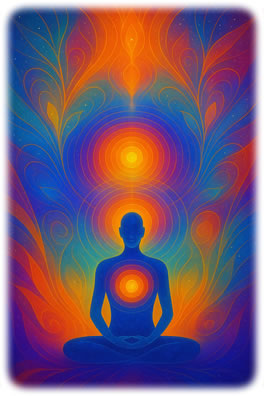
Your body does not merely hear sound — it is sound.
Every cell hums with vibration. Every tissue resonates like a string in a grand instrument. Fascia, the intelligent webbing that wraps muscle, bone, and organ, responds instantly to sonic input, transmitting vibration faster than nerve impulses. Bone, crystalline and conductive, carries these frequencies deeply, making the entire skeleton a resonant chamber. Interstitial fluids ripple with each note, translating sonic waves into shifts in chemistry, posture, and emotional tone.
The auditory system — cochlea, ossicles, auditory nerve — is only one portal of reception. The skin listens. The bones listen. The biofield surrounding your body — often called the auric field — listens. Hearing is not localized to the ears, but distributed throughout your being.
The vagus nerve, connecting brainstem to heart, lungs, and gut, responds acutely to tone. Humming, chanting, and coherent music activate it, shifting the body into parasympathetic states of rest, repair, and regeneration. This is not metaphor — it is measurable biology.
To relate to your body as a Sound Temple is to recognize its sensitivity to the sonic environment. Words, tones, music — even silence — shape its internal architecture. Harmonic sound can entrain coherence; dissonant noise can disrupt it. In this way, sound becomes more than sensation — it becomes influence. It becomes medicine.
When you attune to the body’s vibratory intelligence, you do not just listen. You curate. You orchestrate. You become the keeper of your temple’s tone.
The Language of Harmonics
The Language of Harmonics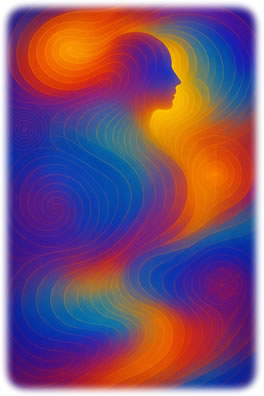
Sound is more than what you hear — it is how you are moved. Beneath music, voice, and noise lies a deeper communication: a language written in vibration. Pitch, tone, tempo, and volume are not just musical descriptors; they are the elemental grammar of resonance, shaping physiology, emotion, and awareness with every wave.
Pitch is the vertical axis of sound — high or low, it determines where in the body resonance is felt. Low tones tend to ground, drawing awareness downward into the pelvis, feet, and earth. High tones uplift, opening the crown, eyes, and upper spine. But pitch alone does not define effect. Intention modulates outcome. A simple hum, offered with presence, can shift more than the most complex scale performed without soul.
Tone is the emotional signature of sound — its color, its character. A clear, open tone invites coherence and trust. A strained or distorted tone may agitate or alert the system. The body reads tone faster than words. It knows when a voice is safe, when a song is sincere.
Tempo is rhythm’s pacing — it regulates breath, brainwaves, and heartbeat. Slow, spacious tempos entrain the nervous system into parasympathetic calm, allowing rest, integration, and healing. Faster tempos can energize or destabilize, depending on the field they enter and the intention they carry.
Volume is not simply loudness — it is presence. A whisper can pierce illusion. A soft hum, paired with breath, can open gates that shouting cannot. Loudness is not power. Power lives in precision — in the alignment between sound, intention, and awareness.
And beyond all these is intention — the invisible architect of effect. Two identical sounds will resonate differently if the hearts behind them are not the same. The body knows this. The field feels it. Harmonics are not just physics; they are felt truths.
To become fluent in the language of harmonics is not to master a technique — it is to listen. To feel. To ask, not only What is this sound? but What is it doing to me? To the space? To the breath of the moment?
In this way, you reclaim sound not as background noise or entertainment, but as a living transmission — a tool for coherence, a bridge between worlds.
The Unheard Orchestra
The Unheard Orchestra
Not all sound is heard.
Much of the sonic world exists beyond the range of human ears, yet it still speaks—profoundly and continuously—to the body and the field around it. Infrasound, with frequencies below 20 Hz, moves slowly, often stirring primal sensations of unease or awe. Ultrasound, above 20,000 Hz, bypasses conscious hearing altogether, entering directly through tissue, fluid, and bone.
Then there are vibrational forces not carried on acoustic waves at all. Electromagnetic fields (EMFs), though silent to the ear, are not silent to the nervous system. They form a kind of ambient signal bath — one that can either harmonize or fragment, depending on its coherence. Artificial EMFs from Wi-Fi routers, cell towers, and digital devices, though invisible, are felt. Their rhythms—erratic or stable—shape physiology, attention, and sleep cycles.
Nature, too, plays its part in this unheard orchestra. The Earth itself sings. Schumann resonances—global electromagnetic pulses born of lightning and atmospheric cavity—create a planetary rhythm that subtly entrains brainwaves and bodily cycles. When geomagnetic conditions shift, human moods, focus, and circadian patterns often shift with them. Whether we are aware of it or not, our biology is listening.
And then there are the transmissions that arise in stillness: subtle inner tones, bone-felt vibrations, and the quiet messages that surface when outer sound recedes. These often arrive as intuition, resonance, or spontaneous insight—sensed more than heard.
To attune to the Unheard Orchestra is to reawaken your felt sense. It is to notice how a room, a device, a place in nature impacts what you sense — not emotionally, but vibrationally. Do your tissues tighten? Does your breath deepen? Do you sense expansion or compression? These are your body’s instruments of discernment.
The more you listen to what is not heard, the more you become sovereign in a world saturated with invisible influence. Here, listening is not about sound — it is about signal. It is about tuning.
The Sonic Mirror
The Sonic Mirror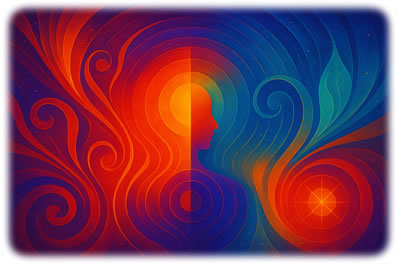
Not all sound is medicine.
Just as food can nourish or fragment the body, sound, too, carries a spectrum of effects—harmful, neutral, or healing—depending on its coherence and your body’s resonance with it. Your nervous system is not simply a passive receiver; it is a mirror, constantly reflecting the vibrational environment around you.
Harmful sound is often chaotic, compressed, or synthetic. Sirens, fluorescent lighting hums, relentless traffic, digital static—these frequencies may not seem loud, but their incoherence subtly agitates. They tighten fascia, dysregulate breath, and cloud the subtle clarity of perception. Over time, they accumulate as noise pollution—not just in space, but in the field of your being.
Neutral sound hovers in the background—mechanical fans, distant chatter, ambient drones. At first glance, it seems harmless. But when sustained without awareness, even neutral sound can dull the vibratory field like dust settling on a mirror. Its impact is not in intensity, but in constancy. The body begins to adapt, not harmonize.
Healing sound is coherent, spacious, and alive with intention. It may arise from the human voice—soft speech, humming, sacred chant. It may come through overtone-rich instruments like singing bowls, strings, or flutes. Most often, it is found in Nature.
Nature is the original orchestra of coherence. Its sounds are never random; they evolve in fractal patterns, golden ratios, and temporal intelligence. The gurgle of a stream, the rustle of leaves, the call of a bird—none are static, yet all are stable. These sounds do not command attention. They entrain it. They do not impose—they restore.
To immerse yourself in nature’s soundscape is to place your field in a tuning chamber. A forest is not silent—it is symphonic. A tree does not speak—but it breathes rhythm. Even silence in nature is not empty—it is full of signal.
Begin to listen not just with your ears, but with your fascia, your breath, your heartbeat. Ask: What sounds drain me? What sounds restore me? What does my body say when my ears grow quiet?
This is the beginning of sonic discernment.
In this mirror, sound shows you your state. And with awareness, it helps you remember your tune.
Music as Memory Key
Music as Memory Key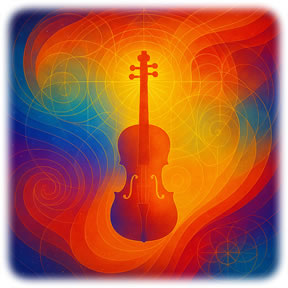
Music is not background—it is architecture. A melody is not merely heard; it enters, bypassing cognition, and moves directly into the emotional and subtle bodies. One note can unlock a lifetime. One chord can restore coherence to a fragmented field.
Across cultures and centuries, this has been known. Indian ragas, Sufi zikrs, African drumming, Gregorian chants—these are not performances; they are codes. Each carries precise understandings of interval, rhythm, and vibrational entrainment. The right song at the right moment is not art—it is medicine.
Music is time made emotional. Its tempo mirrors breath, its rhythm echoes heartbeat, and its tone shapes the field of feeling. This emotional field—sometimes called the "mood body"—influences behavior, memory, and attraction. Sacred music, whether ancient or modern, realigns this field and reawakens soul-level timelines.
Even the silence between notes matters. Rest is part of rhythm. Without pause, tone has no place to land. In this way, music teaches integration—not just through sound, but through space.
Let music become a deliberate act of coherence. Listen not only to the lyrics or melody, but to what stirs beneath. Curate your sonic landscape as you would a sacred altar. Not to entertain, but to entrain.
Because within melody lives memory. And within memory lives the map.
The Body’s Native Instrument
The Body’s Native Instrument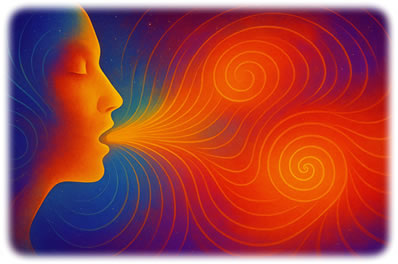
Before instruments. Before language. Before prayer.
There was the hum.
Your voice is the only instrument built from within—the breath-born stringed temple of bone, fascia, fluid, and presence. And long before music became performance, the human body knew how to sound itself into alignment. Humming and vocal toning are not techniques. They are remembrance.
The Healing Hum
Gentle humming stimulates the vagus nerve, the central channel of parasympathetic regulation. Within minutes, the nervous system begins to downshift. Heart rate slows. Breath deepens. Nitric oxide increases, supporting vascular and immune function. The hum becomes coherence—not just emotional, but biological. You are not singing to the body. You are singing from it.
Vocal Toning as Inner Geometry
When you elongate a vowel—Ah, Oh, Ee, Mm—you activate distinct chambers of the body temple. These tones do more than travel through the air; they move through the bones, organs, and cellular waters, creating geometries of sound within you. Each vowel is a vector. Each tone, a tuning fork. With breath and presence, even the softest utterance becomes architecture.
Self-Tuning and Inner Authority
Your voice is not an ornament. It is your most intimate instrument—crafted by breath, bone, and presence. When you hum or tone with intention, you are not performing. You are attuning.
Daily vocal practice becomes a quiet act of inner leadership. No external sound source can offer the precise resonance your own body can generate. In choosing to sound from within, you step into relational authority with your own field. You’re not fixing. You’re listening. Not controlling. Guiding.
This is not performance. It is presence.
You are not a passive recipient of healing.
You are the origin point of coherence.
Concentric Harmony
When tones are shared in group practice, resonance amplifies. Harmonics stack. Overtones bloom. A single room becomes a cathedral—not through doctrine, but through breath. Words are not required. Agreement is not necessary. What emerges is ancient: the felt sense of unified tone.
The body remembers what the mind forgets:
Your voice was never meant to be judged.
It was meant to be used.
Here, you are not trying to sound good.
You are sounding true.
Visible Harmonics
Visible Harmonics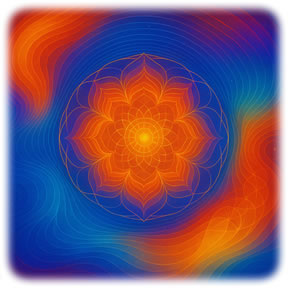
Cymatics—the art and science of making sound visible—reveals what sages and mystics have long intuited: sound is not only a force, but a formative principle. When frequency moves through matter—whether sand, water, or cellular tissue—it organizes. Chaos becomes symmetry. Motion becomes geometry. This is not metaphor. It is pattern, revealed.
On Chladni plates, sound transforms scattered particles into intricate mandalas. The higher the frequency’s coherence, the more refined the pattern. Water, too, becomes a canvas. Droplets exposed to harmonic tones or spoken words shift shape—sometimes elegantly crystalline, sometimes erratic and fractured. Though controversial to some, the essence behind Dr. Masaru Emoto’s work remains clear: intention, frequency, and structure are intimately linked.
The implications reach far beyond the laboratory. Your body—composed largely of water and living tissue—responds to sound in the same way. Cells exposed to coherent vibration align. Dissonant frequencies scatter them. Organs and bones carry unique resonant signatures; when these are disrupted by trauma, illness, or environmental stress, the body’s geometry becomes less ordered. Sound—intentional and harmonic—can restore that order.
To witness sound shaping form is to understand that every word, every tone, every breath carries architecting power. Cymatics is not fringe—it is frontier. It validates what the body already knows: that sound sculpts the seen from the unseen.
You are not simply listening to sound. You are being shaped by it. Every chant, every hum, every whisper creates resonance in the field of your being. Every utterance is a sculptor’s stroke.
Speak as if your voice designs space. Sing as if your cells are listening. Because they are.
The Trinity of Tone
The Trinity of Tone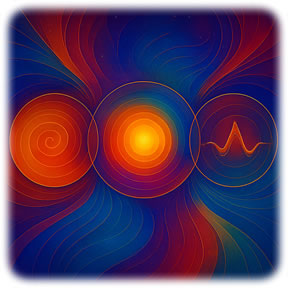
To truly understand sound, one must meet its trinity: frequency, vibration, and sound. These are not interchangeable terms, but distinct dimensions of a single harmonic continuum—each one building upon the last.
Frequency is the code. It is the number of cycles per second, measured in hertz (Hz)—the invisible math of oscillation. Frequency defines pitch, shaping whether a tone is deep and grounding or high and lifting. It is the informational blueprint of energy—the seed pattern behind the wave.
Vibration is the motion. It is frequency made kinetic—the pulse that travels through air, water, tissue, and bone. It is the language the body understands before the mind interprets. You feel it in the hum of your chest, the shiver of your skin, the resonance in your spine. Vibration is the wave in action, frequency embodied.
Sound is the expression. It is what happens when vibration meets a medium and is perceived—by the ear, the skin, the field. Sound carries tone, texture, and emotion. It is vibration made audible, experience made shareable.
Think of a tuning fork. Its frequency is fixed—an exact oscillation. When struck, it vibrates. That vibration travels outward, creating sound—through air, into your bones, into the space around you. Whether your ears register it or not, the field does.
On a metaphysical level, frequency can be seen as intention, vibration as experience, and sound as manifestation. One lives in the causal, one in the sensory, one in the expressive plane. To influence one is to engage all.
This trinity is not a concept to memorize—it is a mirror. Ask yourself: What is the frequency I am emitting? What is the vibration I am feeling? What is the sound I am offering into the world?
To walk with this awareness is to live harmonically—not just in sound, but in presence.
Tuning Keys of the Soul
Tuning Keys of the Soul
Frequencies are more than numbers. They are invitations—vibratory doorways into specific states of awareness, healing, and remembrance. When approached with presence and breath, each becomes a key that unlocks a different chamber of the soul.
111 Hz — The Temple Tone
Known for its resonance through bone and fascia, this tone evokes spacious stillness and a subtle activation of the inner ear. It is often felt in the skull and spine, creating an internal sanctum. Long associated with sacred architecture and altered states, 111 Hz is a threshold tone—used not to escape, but to enter. Use it when seeking inner silence, prayer, or vibrational reset.
432 Hz — The Earth Tuner
Aligned with the natural harmonics of the Earth and golden ratio (phi), 432 Hz grounds while gently expanding awareness. It balances body and field, linking heart coherence with planetary resonance. This frequency is especially potent when used outdoors, during slow breath, or with low vocal toning. It doesn’t push—it entrains.
528 Hz — The Heart Weaver
Called the “love frequency” by some, 528 Hz touches both cellular memory and emotional resilience. It is said to support DNA repair, but even more potently, it dissolves emotional armor. This tone softens grief, smooths discord, and fosters compassionate presence. Let it hum through the chest, or be carried on breath. It weaves coherence into the heart’s field.
963 Hz — The Crown Activator
A crystalline, etheric frequency often linked with expanded awareness and spiritual remembrance. It opens the gateway of knowing beyond language—ideal for meditation, but only when well-grounded. 963 Hz is not for escape, but for anchoring light into matter. Use it sparingly, with reverence and deep listening.
These tones may be received through instruments, vocals, or even mental toning with breath. Let the body decide the pace. Some tones clear; others nourish. None are magic without presence.
Approach each not as a tool to control, but as a teacher to meet. In the field of resonance, your soul remembers what it needs.
The Embodied Portal
The Embodied Portal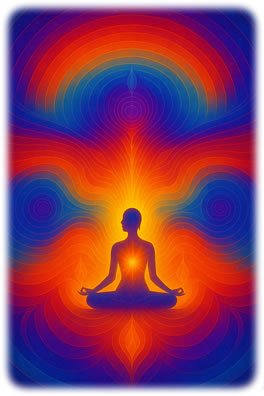
Understanding sound through words changes the mind.
Experiencing sound through the body changes the field.
This final chamber of the Resonance Pathway is not about knowledge—it is about return. Here, sound is not concept but contact. You are invited to enter not with intellect, but with breath. This is the Embodied Portal—a space where vibration becomes sensation, and sensation becomes knowing.
Breath-Sound Synchrony
Begin with slow nasal inhales. Exhale gently on a vowel—Ah, Oh, or Mm—letting the sound arise from the chest, not the throat. Let it ride your breath like mist rising from water. Continue for several minutes. The nervous system will begin to entrain to the rhythm. Feel the tone in your bones, not just your mouth. This is the breath becoming resonance.
Intention-Infused Toning
Choose a tone—vocally or instrumentally—that feels aligned. Pair it with an intention, such as “I return to center” or “I remember wholeness.” Let the tone carry this message, not as a command, but as an offering. Sound becomes the delivery system for consciousness.
Nature Resonance Immersion
Step outside. Barefoot, if possible. Let birdsong, wind, rustling leaves, and distant water reorganize your subtle architecture. Don’t analyze—just receive. Breathe as if the forest were exhaling through you. Nature’s symphony is already tuned. You are simply rejoining it.
Sacred Silence Integration
After sound, pause. Sit in stillness. Not as absence, but as the fertile womb from which sound is born. Listen not for more, but for what remains. This is where coherence crystallizes. Where healing anchors. Let the silence echo.
Mirror Humming
Stand before a mirror. Meet your own eyes. Hum softly—not to perform, but to witness. Let the vibration of your voice create a feedback loop with your gaze. This is self-resonance. Not affirmation, but alignment.
Water-Sound Ritual
Place a bowl of water near you during sound practice. When finished, use it to anoint your hands, face, heart, or plants. Let coherence ripple outward through the elements. Sound imprints water. Water remembers.
These are not techniques. They are thresholds. Enter them gently. Exit slowly.
Sound is not just an input—it is a dialogue.
And your body is always listening.
